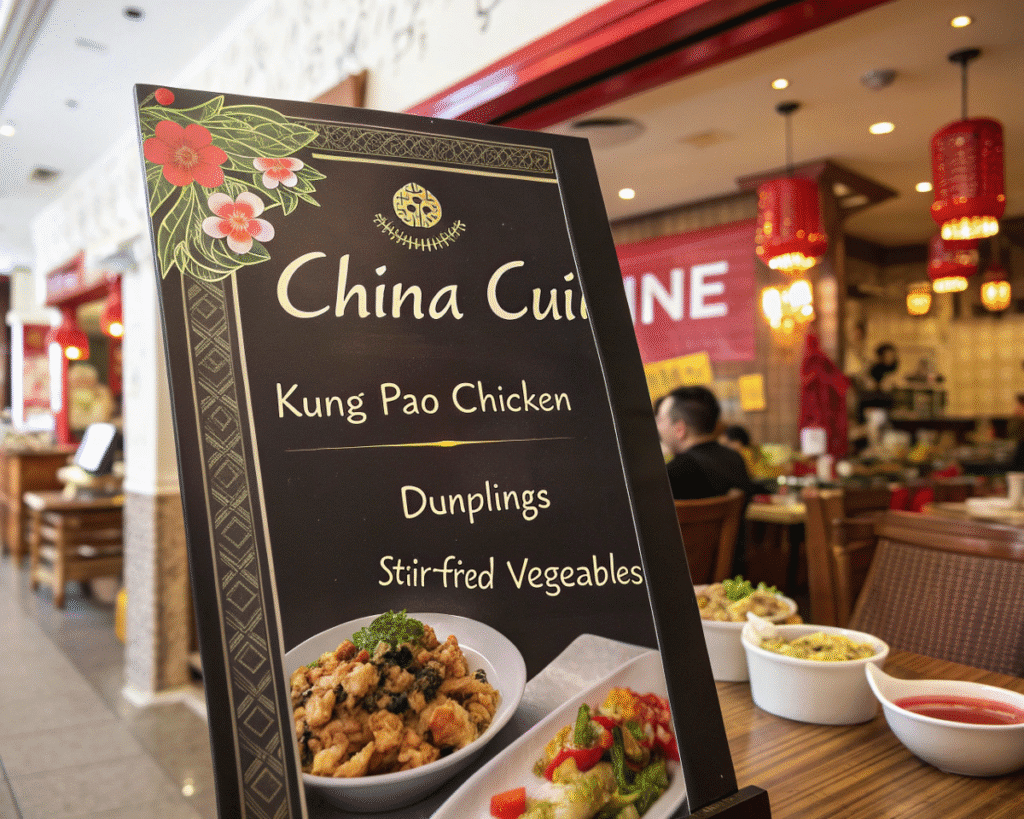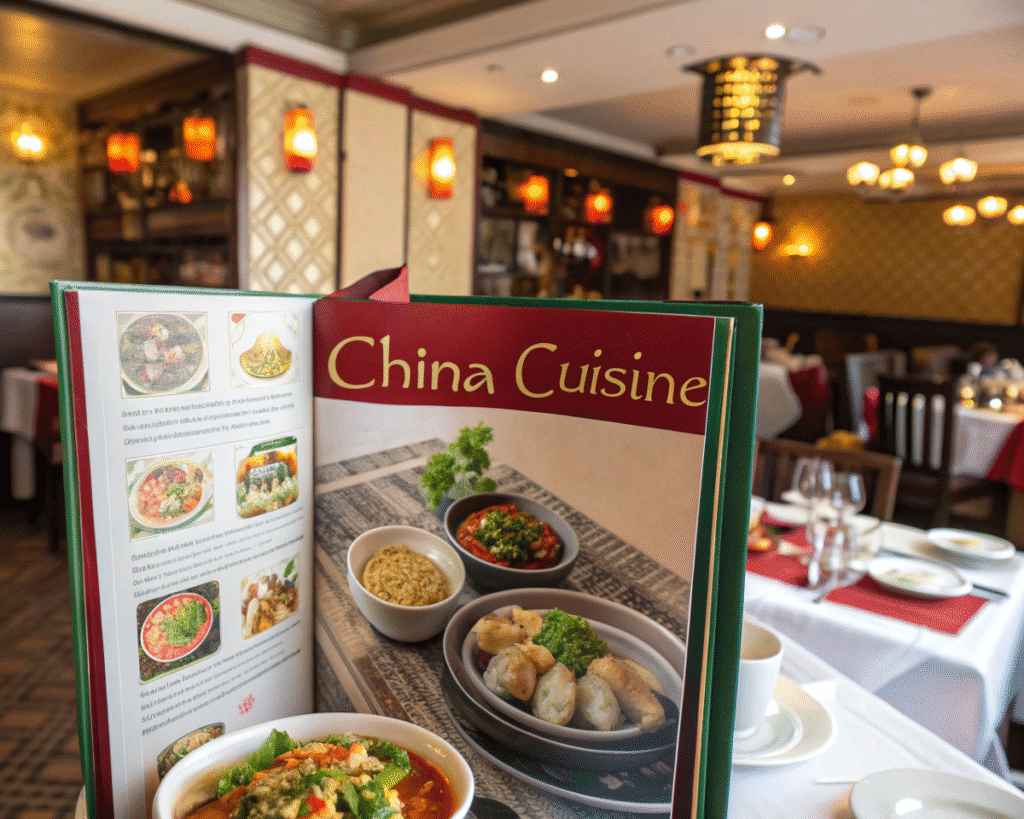
China cuisine menu captivates food lovers worldwide with its bold flavors, diverse dishes, and rich cultural heritage. From sizzling stir-fries to delicate dim sum, Chinese cuisine offers something for every palate. This article explores the essence of a China cuisine menu, its origins, how to create authentic dishes at home, their nutritional value, and key insights into this vibrant culinary tradition.
What Is a China Cuisine Menu?
A China cuisine menu showcases the diversity of Chinese cooking, reflecting regional specialties and time-honored techniques. It includes iconic dishes like Peking duck, mapo tofu, and sweet and sour pork, alongside staples like dumplings, noodles, and rice-based meals. Each region in China contributes unique flavors, creating a menu that spans spicy Sichuan dishes, delicate Cantonese dim sum, and hearty Beijing-style meals.
Chinese cuisine emphasizes balance, incorporating sweet, sour, salty, bitter, and umami tastes. Menus often feature a mix of meat, seafood, vegetables, and tofu, prepared through methods like stir-frying, steaming, braising, and deep-frying. Whether in a bustling restaurant or a home kitchen, a China cuisine menu promises variety and satisfaction.
Origins of Chinese Cuisine
Chinese cuisine traces its roots back thousands of years, evolving through dynasties, trade routes, and cultural exchanges. Each region developed distinct styles based on local ingredients, climate, and traditions. Here’s a look at the major culinary regions that shape a China cuisine menu:
Northern China (Beijing and Shandong)
Northern cuisine, centered in Beijing, features hearty dishes suited for colder climates. Peking duck, with its crispy skin and tender meat, hails from this region. Wheat-based foods like noodles and dumplings dominate, often paired with savory sauces and vinegar-based dips. Shandong cuisine adds seafood and light broths, emphasizing fresh, clean flavors.
Southern China (Cantonese)
Cantonese cuisine, from Guangdong, prioritizes freshness and simplicity. Dim sum, a beloved tradition, offers bite-sized portions of steamed buns, dumplings, and rice rolls. Roasted meats, like char siu (barbecue pork), and delicate soups define this region’s menus. Cantonese dishes often highlight natural flavors with minimal seasoning.
Eastern China (Shanghai and Jiangsu)
Eastern cuisine balances sweet and savory, with dishes like braised pork belly (hong shao rou) and xiaolongbao (soup dumplings). Jiangsu cuisine focuses on delicate presentation, while Shanghai’s dishes often incorporate rice wine and soy sauce for depth. This region’s menus emphasize seafood and river fish.
Western China (Sichuan and Hunan)
Sichuan cuisine brings bold, spicy flavors with ingredients like chili peppers and Sichuan peppercorns. Mapo tofu and kung pao chicken showcase the region’s love for heat and numbing spices. Hunan cuisine, equally spicy, leans into smoked meats and pickled vegetables, offering robust, fiery dishes.
Central China (Anhui and Fujian)
Anhui cuisine uses wild herbs and mountain ingredients, creating earthy, umami-rich dishes. Fujian cuisine, influenced by its coastal location, features seafood and soups, with specialties like Buddha Jumps Over the Wall, a luxurious dish blending multiple ingredients.
These regional styles, shaped by history and geography, form the backbone of any authentic China cuisine menu.
How to Create an Authentic China Cuisine Menu at Home
Crafting a China cuisine menu at home requires understanding key ingredients, techniques, and presentation. Below, we outline steps to build a balanced menu, complete with recipes for popular dishes.
Step 1: Plan Your Menu
A well-rounded China cuisine menu includes an appetizer, main dishes, sides, and a dessert or palate cleanser. Aim for variety in flavors, textures, and cooking methods. For example:
- Appetizer: Spring rolls or cucumber salad
- Main Dishes: Kung pao chicken, mapo tofu, and steamed fish
- Sides: Stir-fried greens and fried rice
- Dessert: Mango pudding or red bean soup
Step 2: Gather Essential Ingredients
Stock your pantry with staples like soy sauce, oyster sauce, hoisin sauce, sesame oil, rice vinegar, and Shaoxing wine. Fresh ingredients like ginger, garlic, scallions, and chili peppers add authenticity. For proteins, choose chicken, pork, beef, tofu, or shrimp. Rice and noodles serve as versatile bases.
Step 3: Master Key Cooking Techniques
Chinese cooking relies on quick, high-heat methods and precise timing. Practice these techniques:
- Stir-Frying: Cook ingredients rapidly in a wok over high heat for crisp textures.
- Steaming: Preserve flavors in dishes like steamed fish or dumplings.
- Braising: Slow-cook meats in soy-based sauces for tenderness, as in red-braised pork.
- Deep-Frying: Achieve crispy textures for dishes like sweet and sour pork.
Step 4: Try These Authentic Recipes
Recipe 1: Kung Pao Chicken (Sichuan)
Ingredients (Serves 4):
- 1 lb chicken breast, cubed
- 1/2 cup roasted peanuts
- 2 tbsp soy sauce
- 1 tbsp Shaoxing wine
- 1 tbsp rice vinegar
- 1 tbsp sugar
- 2 tsp Sichuan peppercorns
- 4 dried red chilies
- 1 red bell pepper, diced
- 3 scallions, chopped
- 2 garlic cloves, minced
- 1-inch ginger, minced
- 2 tbsp vegetable oil
Instructions:
- Marinate chicken in 1 tbsp soy sauce and Shaoxing wine for 15 minutes.
- Mix remaining soy sauce, rice vinegar, and sugar for the sauce.
- Heat oil in a wok over high heat. Add Sichuan peppercorns and chilies, stir-fry for 30 seconds.
- Add chicken, stir-fry until cooked through (5-7 minutes).
- Toss in bell pepper, scallions, garlic, and ginger. Stir-fry for 2 minutes.
- Pour in sauce and peanuts, stir until coated. Serve hot with rice.
Recipe 2: Vegetable Fried Rice
Ingredients (Serves 4):
- 3 cups cooked jasmine rice (day-old works best)
- 1 cup mixed vegetables (carrots, peas, corn)
- 2 eggs, beaten
- 2 tbsp soy sauce
- 1 tbsp sesame oil
- 2 scallions, chopped
- 2 garlic cloves, minced
- 2 tbsp vegetable oil

Instructions:
- Heat vegetable oil in a wok over medium-high heat.
- Add garlic and stir-fry for 30 seconds.
- Push garlic to the side, pour in eggs, and scramble until set.
- Add vegetables, stir-fry for 2-3 minutes.
- Add rice, breaking up clumps, and stir-fry for 3 minutes.
- Drizzle soy sauce and sesame oil, toss in scallions, and serve.
Recipe 3: Mapo Tofu (Sichuan)
Ingredients (Serves 4):
- 1 lb soft tofu, cubed
- 1/2 lb ground pork
- 2 tbsp doubanjiang (spicy bean paste)
- 1 tbsp Sichuan peppercorns, ground
- 2 tbsp soy sauce
- 1 tbsp Shaoxing wine
- 1 tsp sugar
- 2 garlic cloves, minced
- 1-inch ginger, minced
- 1 cup chicken broth
- 2 scallions, chopped
- 2 tbsp vegetable oil
Instructions:
- Heat oil in a wok over medium heat. Add doubanjiang, garlic, and ginger, stir-fry for 1 minute.
- Add pork, cook until browned (3-4 minutes).
- Stir in soy sauce, Shaoxing wine, sugar, and broth. Bring to a simmer.
- Gently add tofu, simmer for 5 minutes.
- Sprinkle with Sichuan peppercorns and scallions. Serve with rice.
Step 5: Present Your Dishes
Serve dishes family-style, with shared plates in the center of the table. Pair with jasmine tea or a light soup to cleanse the palate. Use chopsticks and small bowls for an authentic experience.
Nutritional Value of a China Cuisine Menu
Chinese cuisine offers a range of nutritional benefits, depending on the ingredients and preparation methods. Here’s a breakdown of the nutritional aspects of common dishes on a China cuisine menu:
Macronutrients
- Proteins: Dishes like kung pao chicken, steamed fish, and mapo tofu provide high-quality protein from chicken, pork, fish, or tofu. A 100g serving of chicken or pork offers 20-25g of protein, supporting muscle health.
- Carbohydrates: Rice and noodles, staples in Chinese meals, deliver energy-rich carbs. A cup of cooked rice contains about 45g of carbs, while whole-grain options add fiber.
- Fats: Stir-fried dishes often use oils like vegetable or sesame, contributing healthy fats. For example, a tablespoon of sesame oil adds 14g of fat, including heart-healthy unsaturated fats.
Micronutrients
- Vitamins: Vegetables like bok choy, bell peppers, and scallions provide vitamins A, C, and K. A cup of stir-fried bok choy offers over 100% of the daily vitamin C requirement.
- Minerals: Soy-based ingredients and seafood supply iron, calcium, and zinc. Tofu, for instance, is rich in calcium, with 100g providing 350mg.
Health Considerations
- Low-Calorie Options: Steamed dishes, like dim sum or steamed fish, are low in calories (100-200 kcal per serving) and ideal for weight management.
- High-Fiber Choices: Vegetable-heavy dishes and whole-grain rice boost fiber intake, aiding digestion.
- Sodium Content: Soy sauce and fermented pastes can increase sodium levels. Opt for low-sodium soy sauce to reduce intake.
- Balance: Chinese cuisine emphasizes balance, combining protein, carbs, and vegetables in one meal, promoting satiety and nutrient diversity.
To maximize health benefits, choose steaming or stir-frying over deep-frying and incorporate colorful vegetables for antioxidants.
Cultural Significance of a China Cuisine Menu
A China cuisine menu reflects more than just food—it embodies history, philosophy, and community. Chinese dining emphasizes harmony, with dishes designed to balance yin (cooling) and yang (warming) elements. Family-style meals foster togetherness, as diners share plates and stories.
Festivals like Chinese New Year feature symbolic dishes, such as dumplings for wealth and fish for prosperity. Regional menus also reflect local traditions—Sichuan’s fiery dishes embody its bold culture, while Cantonese dim sum showcases refinement.
Tips for Enjoying a China Cuisine Menu
- Explore Regional Variety: Try dishes from different regions to appreciate the diversity of Chinese cuisine.
- Pair with Tea: Jasmine or oolong tea complements rich flavors and aids digestion.
- Experiment with Spices: Add Sichuan peppercorns or chili oil for an authentic kick.
- Visit Authentic Restaurants: Seek out restaurants specializing in regional cuisines for inspiration.
A China cuisine menu offers a gateway to one of the world’s most vibrant culinary traditions. From its ancient origins to its diverse regional styles, Chinese cuisine captivates with bold flavors and balanced nutrition. By mastering key ingredients, techniques, and recipes like kung pao chicken or mapo tofu, you can recreate an authentic China cuisine menu at home. Whether you’re savoring dim sum or fiery Sichuan dishes, this cuisine promises a delicious journey through culture and taste.

